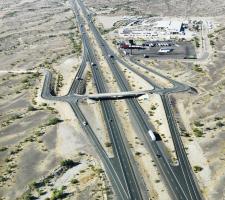
Floating car data has matured to a point where it offers a viable real-time traffic monitoring solution
One of the biggest problems facing
Many US states have only a rudimentary ITS network and no 511 system. This, along with the current economic situation, is proving a challenge to everyone. Funds for ITS are shrinking, making the maintenance of existing systems challenging and the installation of additional equipment and services unlikely. Now more than ever it is time for those with vision to step forward with solutions that offer significant reductions in both installation and operating costs. Many readers will dismiss this statement as impossible to achieve in real life. It is not so.
Identifying change
Radical changes are called for and radical solutions are available, but they may be outside the traditional ITS model. The current generation of ITS equipment is both expensive to initially purchase and in many cases has proven to be far less reliable than predicted once in service, necessitating constant maintenance along with significant utility power bills. Jurisdictions should take a careful look at ITS equipment that is already due for replacement and identify an alternative that offers an elimination of operating costs and maintenance. New entrants, meanwhile, shouldn't even consider installing field equipment until they are absolutely certain that there is no other way, without major capital expenditure, of achieving what is wanted.An example of this would be the purchase of probe data instead of building a field data collection system. In one US state the annual cost of the power for the detectors is the same as the annual cost to purchase the data from a probe data supplier. If that state were to abandon the replacement of the worn-out existing equipment, at a stroke a huge capital sum would be saved and future maintenance costs entirely eliminated.
Doubters will say that this is all very well, that this is unproven technology. And what if the data provider goes out of business? In defence of probe data, which arguably had a poor start five years ago, a newer generation has evolved and is proving to be as good as if not better than conventionally collected data. The I-95 Corridor Coalition, for instance, has established a relationship with a probe data provider. Each month a team from the University of Maryland carries out a field test to compare their field-collected data for a section of freeway with that provided by the probe data supplier. The results speak for themselves: the quality of the probe data meets or exceeds that of field devices. Car manufacturers are already allowing for the provision of probe-generated traffic data in higher-end vehicles. This will undoubtedly percolate down to all new vehicles in a few years.
Cellular solutions
New adopters of ITS may be considering installing fibre-optic networks. The attraction of a robust, owned network appears to have many advantages until expansion or changes are required. Accidental damage to a fibre-optic cable may take many years to repair or replace. One state had almost the entire ITS on a freeway eliminated for four years whilst the irreparably damaged fibre-optic cables and field equipment power was replaced. The inevitable question is: what new technology can replace the need for an extensive fibre-optic network? We need only look as far as the cellular telephone industry, which has grown enormously in the last 10 years.Today the cellular telephone is as common as a wristwatch. In fact, the cellular telephone itself has evolved very quickly from just a wireless telephone to a combined computer, camera and GPS. The result has been that the cellular infrastructure has developed to a point where today 3G, the third generation of cellular technology, is present along almost every Interstate in the lower 48 states and 4G, the fourth generation, is available in many cities from a smaller wireless carrier. The '500lb gorilla' is 4G LTE, which the wireless business should be offering by the time you read this article. It's an accepted fact that once something becomes a commodity its price falls dramatically. This is already happening in the wireless communications business.
There are two key ITS devices that will need to remain deployed in the field. First consider the Variable Message Sign (VMS), variously described as a changeable or dynamic message sign. Currently this is the only way to provide real-time traffic information to everyone. It can be argued that the 511 service, interactive, vehicle-mounted GPS, in-vehicle systems and possibly Intellidrive will eliminate the need for VMS, but it is probably too early to do this now. Nevertheless at the rate of development of in-vehicle information system adoption, the VMS could be extinct in less than 10 years. Jurisdictions should plan accordingly. Communicating with a VMS in an urban area is typically achieved using fibre-optic cable. In areas remote from a fibre connection dial-up services over the public telephone network are used. VMS are power hogs and there is unfortunately no cost-effective renewable energy solution available at present. There is a considerable initial cost involved in getting power to a VMS, so the choice of location is critical in minimising the initial cost of the power installation. Consider using a metered power supply as it may very well prove cheaper than a flat rate. LED VMS only consume power when displaying a message, unlike the shuttered fibre-optic designs that have lamps burning constantly whether a message is being displayed or not. When changing to LED technology a change in power tariff should not be overlooked.
The other key ITS device which will exist for at least the foreseeable future is the CCTV camera. CCTV provides the eyes of the staff at the Transportation Management Centre (TMC), in that it provides visual confirmation of incidents and a means of managing incidents. For a CCTV camera to successfully operate it needs a reliable communications system. Up until recently the only proven, reliable communications has been by means of a fibre-optic connection. The arrival of 3G and 4G cellular technology opens up a whole new opportunity to make a broadband connection without the expense of installing such a connection to every camera. A wireless cellular connection will almost certainly be cheaper to operate than a wired telephone connection. It will eliminate call costs and, more importantly, both the initial telephone line installation cost and disruption when the wired service fails. Fortunately, CCTV cameras are quite frugal with electrical power so if a connection to the power utility is not readily available then a renewable power system employing back-up batteries is appropriate. At least one manufacturer offers a complete CCTV package that can be delivered and installed on a pole without the need for power or (by virtue of having an integral 3G/4G modem) communication connection. Such a package offers the capability to install a CCTV virtually anywhere and to have it operating as soon as installation is complete.
Finally there is the TMC, where resides the human element that interprets the field data and initiates incident response plans. The advance of technology provides the opportunity to consolidate TMCs, especially out-of-hours operations. By selecting a robust ATMS software package with comprehensive centre-to-centre communications the management of incidents and the transfer of data becomes a simple process. This offers the possibility of multi-state TMCs.
Addressing cost
Standalone websites and 511 systems owned and operated by states require considerable investment and ongoing maintenance. At least one state is on its third 511 system having chosen to purchase and operate the hardware. A number of 511 service providers exist and they can provide 511 service and maintenance costs at a fraction of the cost of owning a 511 system. Upgrades are automatic and the sharing of telecommunications infrastructure means that only a minimum number of incoming lines need to be purchased with a shared overflow, thus significantly reducing costs without degrading the service during peak calling times such as a weather event. Taken a stage further one state has outsourced its 511 service to a provider that does all of the above without any cost to the state or taxpayer. This is achieved by sponsorship and has provided a saving of the order of $0.5 million per year. In addition the provider takes care of the traffic website, thus further reducing that state's IT expenditure.Sponsorship may be new or even unknown to many states but it has been successful in a number of states to pay for all or part of the costs of providing roadside incident management. State vehicles patrolling urban freeways are potential moving billboards that can generate valuable revenue. It's fair to declare that not all states may be in a position to generate sufficient sponsorship funds to pay for their roadside support, 511 service or website, but even if some funds can be generated this reduces the operating costs and may even ensure the long-term viability of a service.
By adopting cost-effective solutions to ITS deployment the US can rapidly accelerate its use of ITS yet greatly reduce both the initial and day-to-day operating costs. Visionaries are needed to step forward and lead the way.











